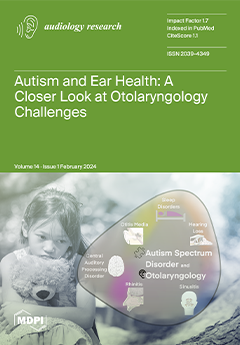Background: Since the discovery of the perilymphatic fistula (PLF), the diagnosis and treatment remain controversial. If successfully recognized, the PLF is surgically repairable with an obliteration of the fistula site. Successful treatment has a major impact on patient’s quality of life with an
[...] Read more.
Background: Since the discovery of the perilymphatic fistula (PLF), the diagnosis and treatment remain controversial. If successfully recognized, the PLF is surgically repairable with an obliteration of the fistula site. Successful treatment has a major impact on patient’s quality of life with an improvement in their audiological and vestibular symptoms.
Objective: To prospectively investigate patients’ clinical and audiological evolution with PLF suspicion after middle ear exploration and obliteration of the round and oval window.
Study Design: Prospective comparative study.
Setting: Tertiary care center.
Methods: Patients were divided into two groups: Group I consisted of patients where no PLF had been identified intraoperatively at the oval and/or at the round window, and Group II consisted of patients where a fistula had been visualized. Patient assessment was a combination of past medical history, the presence of any risk factors, cochlear and vestibular symptoms, a physical examination, temporal bone imaging, audiograms, and a videonystagmogram (VNG).
Results: A total of 98 patients were divided into two groups: 62 in Group I and 36 in Group II. A statistically significant difference regarding gender was observed in Group II (83.3% of males vs. 16.7% of females,
p = 0.008). A total of 14 cases (4 and 10 in Groups I and II, respectively) were operated for a recurrent PLF. Fat graft material was used in the majority of their previous surgery; however, no difference was found when comparing fat to other materials. In addition, no statistically significant difference was noted between Groups I and II concerning predisposing factors, imaging, VNG, symptom evolution, or a physical exam before the surgery and at 12 months post-operative. However, both groups showed statistically significant hearing and vestibular improvement. On the other hand, the air conduction (AC) and bone conduction (BC) at each frequency were not statistically different between the two groups before surgery but showed statistically significant improvement at 12 months post-operatively, especially for the BC at the frequencies 250 (
p = 0.02), 500 (
p = 0.0008), and 1000 Hz (
p = 0.04).
Conclusions: Whenever you suspect a perilymphatic fistula, do not hesitate to explore middle ear and do window obliterations using a tragal perichondrium material. Our data showed that cochlear and vestibular symptoms improved whether a fistula had been identified or not.
Full article






